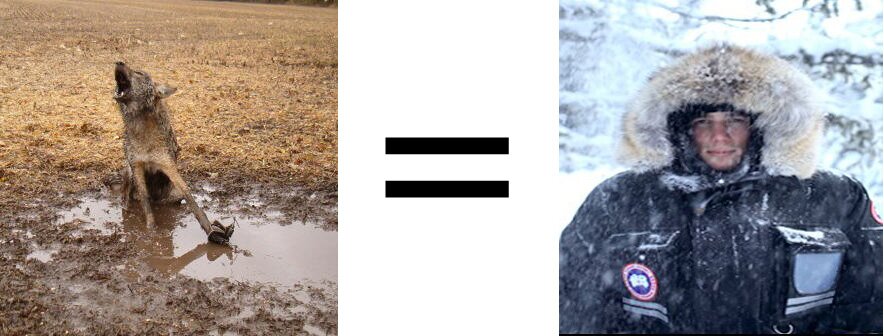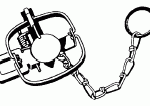The following claims were taken directly from Canada Goose’s ‘fur policy‘ as it appeared February 3, 2012.
Canada Goose is a Canadian outdoor clothing company who uses real coyote fur as trim on the hoods of their parkas. Despite the fact that the majority of Canadians abhor the use of fur, Canada Goose actually celebrates the trapping and killing of wildlife for unnecessary, decorative fur trim.
In an effort to sway the public, Canada Goose has a “fur policy”. Unfortunately the statements made in this “policy” are not intended to inform the discussion on fur, but rather misinform the public with the sole purpose of carrying on with ‘business as usual’. Most Canadians already know that the fur trade is inherently violent, and that fur products derived from this violence are also inherently frivolous. However, in an effort to combat the slick PR messaging employed by Canada Goose, we have taken the liberty of deconstructing their “fur policy” point by point.
CLAIM: “Activist groups often portray old-fashioned steel-toothed leg-hold traps, but these are now only found in museums. Modern foothold traps can restrain animals with little or no injuries.”
The infamous leg-hold trap is STILL legal in every province and territory across Canada and remains the most widely used, despite being banned in many countries (including the EU), as well as Florida, Rhode Island, New Jersey and Arizona. The American Veterinary Association, the American Animal Hospital Association, the World Veterinary Association, the National Animal Control Association, the Humane Society of the United States and the Sierra Club all oppose the leg-hold trap. While leg-hold traps with ‘teeth’ have been banned, all leg-hold traps (including the remaining models) have the same intention: to prevent the escape of an animal who is fighting for his or her life. Many animals die trying to free themselves, as well as from dehydration, blood loss and hypothermia. Some animals become so desperate, they break teeth chewing and/or twisting off their own limbs to escape. For more information about trapping in Canada, please click here.
CLAIM: “Some online videos shown by animal rights activists display coyotes or foxes struggling to free themselves from restraining traps, but this is because they are being approached by a human.”
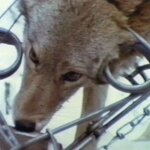 This is demonstrably false. Animals struggle because they are frightened and do not want to be restrained. There is no better example of this than our film, Crying Shame. All footage was collected by a licensed trapper on a registered trapline during trapping season and feature traps still in frequent use today. The animals were filmed by automatic cameras – no “humans were approaching” – and the reaction is the same.
This is demonstrably false. Animals struggle because they are frightened and do not want to be restrained. There is no better example of this than our film, Crying Shame. All footage was collected by a licensed trapper on a registered trapline during trapping season and feature traps still in frequent use today. The animals were filmed by automatic cameras – no “humans were approaching” – and the reaction is the same.
CLAIM: “Research shows that once these animals know they cannot escape, they generally lie down and wait quietly until they are quickly dispatched when the trapper arrives. Additionally, many of these videos are quite old and show methods that are no longer used.”
Common sense refutes this claim. What sort of evolutionary function would it serve if a wild animal, upon finding themselves trapped or confined, simply “laid down and waited”? Such claims are nonsense. Evidence shows that their desire to free themselves is so strong that animals break teeth and bones trying to escape. Once again, we encourage you to view our video, Crying Shame. All footage was collected by a licensed trapper on a registered trapline during trapping season and feature traps still in frequent use today. If a trapped animal is laying down, it is likely because she has exhausted herself trying to escape, and is feeling starved, dehydrated, or is dying from blood loss, hypothermia, etc.
CLAIM: “For Canada Goose, functionality is paramount and our use of fur is strictly for functional purpose. Our jackets are built to be used in the coldest places on earth where skin around the face can freeze in an instant….we have learned from the native people of Canada’s North and from a major research study conducted at the University of Michigan that there are three types of fur that truly protect people from frostbite.”
Canada Goose loves to evoke iconic imagery of research scientists hiking along the unforgiving Arctic tundra. So if Canada Goose makes coats for the “coldest places on earth”, why are they all over Toronto, Montreal, Vancouver, and every other city in Canada? And moreover, why has it been described as “the uniform of the inner city aged 16-to-24 year olds” by Randy Harris, president of market research firm Trendex North America?
 The truth is that around $50 million of Canada Goose’s annual sales are what CEO Dani Reiss calls “fashion-driven”. Canada Goose products are a fashion trend and warmth is merely a selling feature. Reiss even admits that the badge on the arm of a Canada Goose jacket makes “people feel like they belong to a club”. A Canada Goose jacket is about status. Reiss claims that Canada Goose is the “Swiss watch of apparel”, the “Land Rover of outerwear”. In reality, Canada Goose is much more like a Hummer: excessive, irresponsible, unnecessary, and sooner than many will expect, embarrassing.
The truth is that around $50 million of Canada Goose’s annual sales are what CEO Dani Reiss calls “fashion-driven”. Canada Goose products are a fashion trend and warmth is merely a selling feature. Reiss even admits that the badge on the arm of a Canada Goose jacket makes “people feel like they belong to a club”. A Canada Goose jacket is about status. Reiss claims that Canada Goose is the “Swiss watch of apparel”, the “Land Rover of outerwear”. In reality, Canada Goose is much more like a Hummer: excessive, irresponsible, unnecessary, and sooner than many will expect, embarrassing.
Regarding the University of Michigan “fur study” they cite, we could not find any such study. We even contacted the University of Michigan, who has no such study in their records. Unfortunately, Canada Goose refuses to provide a reference for this claim.
Canada Goose Claim: “In these environments, when life is on the line, fur is not just the best choice, but the only choice. We do not use fake or “faux” fur because it simply does not protect as well as real coyote fur. Faux fur is only a fashion statement. It does not act in the same way that real fur does to protect skin from frostbite”.
Any kind of fur, including coyote fur, is NOT necessary. Despite what Canada Goose would have you believe, people can and do, climb mountains without fur-trimmed parkas. Lots of competing brands focused on technical performance choose to use synthetic materials (Arc’teryx, Mountain Equipment Coop, Columbia, Patagonia, Fjällräven, etc.). And apart from the hood, Canada Goose jackets are made with synthetic fabrics (polyester, nylon and much of it is treated with durable water repellent (DWR) finish). And most importantly– the vast majority of people do not even live in climates where their skin can freeze in an instant. The majority of the Canadian population lives in large urban cities near the southern border.
CLAIM: The fur that we do use is acquired in the most humane ways and we adhere to the guidelines of the Fur Council of Canada that governs fur use in our country.
While this claim would appear as though a lengthy response is in order, that is not the case. Why? Because the Fur Council of Canada has no legal authority in Canada. They are simply the marketing body of the fur industry and as such, they represent the interests of the fur industry and no one else. In other words: ‘adhering to their guidelines’ means nothing.
Additionally, Canada’s Competition Act does not restrict the use of terms such as ‘humane’, which means that the fur industry can, and does, capitalize off of the emotional weight people give to this term.
CLAIM: The fur industry is an excellent example of an industry based on sustainable use.
This is probably the most common argument made by Canada Goose in favour of fur, but a quick overview of trapping and fur farming leave little room for debate: the fur industry, in addition to being archaic and cruel, is not sustainable or ‘green’ or ‘environmentally-friendly’.
To begin, traps are not selective, which means endangered species can and do get caught (see next claim). In January 2011, a Manitoba trapper found a dead, full grown male cougar in his trap (which was meant for coyotes). The cougar is listed as a protected species, so under the law the trapper had to report it to Manitoba Conservation. The cougar was only the fourth found in the province since 1973. There are also serious environmental concerns with the legal trapping of at-risk species and the overall inability to enforce the laws that do exist.
The majority of trapping in Canada occurs on registered traplines (on federally owned land) with some as big as 500 square miles. In order for trappers to travel to, and patrol their traplines in the woods, as well as to transport dead animals and trapping equipment, automobiles and/or snowmobiles are routinely used. In fact, many traplines actually run along makeshift roads so that trappers can drive along from trap to trap. While the industry likes to hark back to the history of trapping, modern trapping relies heavily on fossil fuels. For more information on the environmental issues with trapping, please click here.
80% of the animals killed for fur in Canada come from fur farms (Statistics Canada, 2010). Like other forms of factory farming, it is a highly environmentally destructive process. A 2011 report on mink farming, found that farmed fur outscores other textiles (by anywhere from 2-28 times) for land use and climate change. The report also found that farmed fur requires up to 20 times more GHGs than other textiles. In addition to being an irresponsible use of resources, the report found that farmed fur outscores other textiles (by anywhere from 2-28 times) for ozone layer depletion, soil and water pollution, and toxic emissions. For each kilogram of factory farmed mink fur, 110 kilograms of carbon dioxide is produced. That is enough to drive a car from Toronto to Nashville. For more information on fur farms and the environment, please click here.
The Fur Council of Canada describes trappers as “practicing conservationists”, as “our “eyes and ears” on the land”. They claim that “they are the first to sound the alarm when wildlife habitat is threatened by pollution or poorly planned development projects”. What about when trapping practices threaten wildlife? Do they sound the alarm then? Despite claims about a long history of stewardship, the North American Sea Mink, which used to live in the coastal waters of Newfoundland, was completely eradicated by the fur trade, and is now extinct. While the industry may claim to have learned their lesson, the Newfoundland Marten is now considered a ‘Threatened’ Species, with approximately 300 members remaining (one of the primary causes being trapping). Other species who have been historically targeted by trappers are now threatened or endangered. Some of these include the Sea Otter (Threatened), the Swift Fox (Threatened) and the infamous Eastern Wolverine.
CLAIM: All the furs used by the trade are abundant. Absolutely no endangered species are used.
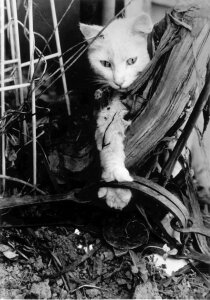 Canada Goose brags that they don’t use endangered species in their products when in actuality, it would be against the law for them to do so. But they fail to mention that traps are indiscriminate, which means that any person or animal (including pets and endangered species) can and do get caught in traps. The reported numbers (which are considered very low) are disturbing. For example, the American Veterinary Medical Association reports that ‘non-target animals’ (or ‘trash’ animals as they are referred to by industry) account for up to 67% of total catch. Some estimate that for every ‘target’ animal, up to 10 ‘trash’ animals are killed. These trash animals routinely include our dogs and cats, as well as endangered species. As another example: in March 2012, in Constance Lake, Ontario, Larry Gillis and grandson Jeff Gillis caught an Endangered Eastern Wolverine (while targeting lynx). Gillis claims he didn’t realize wolverines were an endangered species until a marine biologist in Hearst had the Ministry of Natural Resources confiscate the body. “They said I couldn’t sell it or possess it.” Gillis said. (Wawatay News)
Canada Goose brags that they don’t use endangered species in their products when in actuality, it would be against the law for them to do so. But they fail to mention that traps are indiscriminate, which means that any person or animal (including pets and endangered species) can and do get caught in traps. The reported numbers (which are considered very low) are disturbing. For example, the American Veterinary Medical Association reports that ‘non-target animals’ (or ‘trash’ animals as they are referred to by industry) account for up to 67% of total catch. Some estimate that for every ‘target’ animal, up to 10 ‘trash’ animals are killed. These trash animals routinely include our dogs and cats, as well as endangered species. As another example: in March 2012, in Constance Lake, Ontario, Larry Gillis and grandson Jeff Gillis caught an Endangered Eastern Wolverine (while targeting lynx). Gillis claims he didn’t realize wolverines were an endangered species until a marine biologist in Hearst had the Ministry of Natural Resources confiscate the body. “They said I couldn’t sell it or possess it.” Gillis said. (Wawatay News)
It is important to note that there is almost no incentive for trappers to report non-target catches, especially if they are endangered animals (which could result in penalization) and there is virtually no way to enforce the laws that make it illegal to catch endangered species. Nor is there any way to prevent it, as traps don’t have the capacity to discriminate. So while Canada Goose, and the industry at large can’t ‘use’ endangered species, undoubtedly their use of fur results in the death of endangered species (as well as cats, dogs and other ‘non-target’ animals). The total casualties due to the fur trim on a Canada Goose coat is greater than the single coyote whose fur is now trim. For more information about non-target animals, please click here.
CLAIM: “In fact, Canada is the world leader in scientific research to develop the most humane trapping systems possible, and has invested more than $20 million in trap research and development, providing the scientific basis for the Agreement on International Humane Trapping Standards that has been signed by Canada, the European Union and Russia. Only furs taken with methods that meet this international standard may be produced in Canada. Trappers in Canada are licensed and they cannot renew their licenses without taking training courses to learn how to use the new and more humane methods.”
In 1995, the European Union passed a progressive ban on the use of leg-hold traps in all its member countries, as well as a ban on fur from any country still using leg-hold traps. In response, Canada threatened the EU with economic punishments under GATT and the WTO. Sadly, the EU conceded and exempted Canada from their ban when Canada, the USA and Russia instead proposed “The Agreement on International Humane Trapping Standards” (AIHTS). This agreement was based on the commitment to develop and use only “humane” traps, and with the understanding that the agreement would lead to the eventual banning of the leg-hold trap. Sadly, what it did instead was put an official ‘humane’ seal of approval on business-as-usual and provided the fur industry with a sound bite about their commitment to ‘humaneness’ while changing very little about the actual practices. This exercise in deception exists entirely because the majority of the Canadian and international public are not comfortable with, or supportive of, the trapping of animals.
actual practices. This exercise in deception exists entirely because the majority of the Canadian and international public are not comfortable with, or supportive of, the trapping of animals.
The standards apply to 12 animals routinely killed for fur (beaver, muskrat, otter, weasel, marten, fisher, raccoon, badger, coyote, wolf, lynx and bobcat). Noticeably missing from the agreement are minks, foxes, and wolverines. Although the steel jaw leg-hold trap is no longer permitted, superficially altered versions of the trap remain the standard. This is contrary to the entire purpose of the agreement, which was to ban the leg-hold trap entirely. As it stands, the same traps that have been used for 40 years are still allowed, including snares, which are considered extremely inhumane even by moderate groups like the Canadian Federation of Humane Societies. For more information about the AIHTS, click here.
CLAIM: “…we take pride in the fact that by supporting this sustainable industry we are also supporting the native Canadian communities of the North and their centuries-old ways of life that are now being threatened.”
Canada Goose, and the fur industry at large, claim to support indigenous populations by using fur, but in reality, less than 2% of Canada’s aboriginal population is involved in the fur trade. Aboriginal trappers, on average, earn less than $400 per year, and receive only 1% of the profits of the Canadian fur industry. And it goes beyond mere misrepresentation: the fur industry has continually opposed indigenous efforts to label fur as ‘native trapped’. Why? Because the industry doesn’t want the Canadian public to know how little of its total fur production comes from the indigenous populations it so fervently claims to support.
Low pelt prices, fluctuating demand, and high expenses (e.g.: gasoline, trapline permits, etc.) mean that for many trappers, indigenous or not, trapping has now become a hobby or a seasonal supplementary income. It is not a livelihood. Paul Hollingsworth, founder of Native/Animal Brotherhood explains that the industry continues “to promote the myth that trapping is culturally and economically central to Canada’s Natives”. For more information on the ‘Indigenous Trap’ used by the fur trade, please click here.
CLAIM: “These communities are ethical in their fundamental approach to hunting: We strongly identify with the value systems of these communities, and make a commitment that carries over to the way we do business: Canada Goose does not buy fur from farms of any sort – ever.”
Canada Goose couldn’t buy from fur farms even if they wanted to, because there are no coyote fur farms. Coyote fur can only be obtained by trapping them in leg-hold, Conibear or snare traps. Canada Goose turns their nose up at fur farming, as though trapping has an outcome that is any happier for the animal. And Canada Goose buys their fur from auction houses that sell all sorts of fur, including farmed fur.
Despite this anti-fur farm stance, Canada Goose has yet to acknowledge the moral dilemma they undoubtedly face over the surge in knock-off Canada Goose products, replete with farmed fur (in some cases even dog fur). By popularizing the fur trend, it is inevitable that the knock-off markets in Asia would respond by using the cheapest fur available to them: dog and cat fur (which is sadly legal in Canada) and other competitors would use farmed fur (Moose Knuckles uses farmed fox fur).
CLAIM: “The environmental benefits to using a natural product are clear when compared with the use of synthetics that are sometimes described as an “ethical” alternative to real fur.”
While the fur industry loves to claim that fur is ‘natural’, a quick overview of fur processing lays that claim to rest. After an animal is killed, their skin is peeled off to create a ‘pelt’, which is the animal’s skin with the hair still attached. Because fur would naturally biodegrade, each pelt must be “dressed” (industry slang for tanned), which stabilizes the collagen or protein fibers in skins, thereby “inhibiting putrefaction” (which is a polite way of saying that it stops the fur from rotting). This process relies heavily on toxic chemicals, including formaldehyde and chromium, which “are listed as carcinogens and are otherwise toxic to humans”. Other chemicals that may be used or emitted in the dressing and dyeing processes and that appear on one or more US government lists of toxic chemicals include aluminum, ammonia, chlorine, chlorobenzene, copper, ethylene glycol, lead, methanol, napthalene, sulfuric acid, toluene and zinc”. Could this be what gave one woman a rash after she started wearing Canada Goose?
Processing fur is so intense that according to Judith Eger, Senior Curator of Mammals in the Department of Natural History of the Royal Ontario Museum, the “harsh tanning, dying and shearing processes” make it almost impossible to determine which species fur is from, as “once the fur has been treated genetic sequences are virtually destroyed”. So claims about Canada Goose’s fur being ‘natural’ are as artificial and processed as the fur itself! And let’s not forget that Canada Goose jackets, apart from the trim on the hood, are made with synthetic fabrics (polyester, nylon and much of it is treated with durable water repellent (DWR) finish).
CLAIM: “Many anti-fur advocacy groups fail to take into account the environmental impact of the production of synthetic fur.”
The Association for the Protection of Fur-Bearing Animals, and most of our supporters, do not advocate the use of fake fur. We believe that fake fur just promotes real fur, and thanks to lax labeling laws in Canada, the fur is often real (dog, cat, rabbit, etc.) despite it appearing fake and not being labeled as real.
CLAIM: “We choose down because it is, without a doubt, the world’s best insulator…Down provides approximately three times the warmth per ounce as synthetics materials…”
The US Army, Marines and Special Forces may beg to differ. PrimaLoft is a synthetic microfibre insulator that was originally developed for the US Army as a water resistant down alternative. Today, Primaloft is the premier supplier of insulation to the US Army, Marines and Special Forces. When it comes to thermal efficiency, Primaloft is a competitive alternative, especially given that down performs poorly as an insulator as soon as it becomes wet, and also has a slow drying rate. Primaloft retains 96% of it’s insulating ability when wet.
Claim: “We continue to look for new ways that we can expand our partnership with PBI and support the organization’s important commitment to the worldwide conservation of the polar bear and its habitat.”
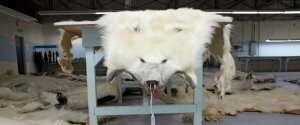
Photograph by Jessica Darmanin
Dani Reiss loves mentioning that Canada Goose is a Platinum sponsor of Polar Bears International, a “conservation group—dedicated to saving polar bears” through “research, education and action”. Reiss is actually also the Chair of the board (conflict of interest, anyone?), and according to his bio, he “has a passionate commitment to polar bears, the Far North, and the preservation of all wild creatures and places.” Well, not all wild creatures…
And as if this isn’t confusing enough, why– if Reiss is deeply committed to preserving polar bears– does he buy his coyote pelts from one of the only two auction houses in Canada that actually sell polar bear pelts (Fur Harvesters Auction in North Bay)?
The bottom line is the bottom line:
Canada Goose has spent too much energy trying to justify and legitimize using fur for their products to back down now. Therefore the public has to expect that in the interest of profit, they will continue to attempt to obfuscate and/or hide the irrefutable cruelty of their decision to use fur through the use of clever PR angles and with the help of the Fur Council of Canada. We hope you’ll find this a useful resource in combating this misinformation campaign.
So what will keep you (and your conscience) warm and cozy?
The alternatives to Canada Goose are endless! Why choose a product that you know involved untold amounts of suffering and violence? Check out our helpful hints here and get familiar with these awesome, progressive, fur-free alternatives:
- Get to know Arc’teryx, Fjällräven, Mountain Equipment Co-Op (MEC), Columbia Sportswear, Patagonia, Helly Hansen, Hoodlamb, Vaute Couture and H&M! In terms of knowing which retail chains are actively fur-free, the Humane Society of the United States has compiled a list here. You may be surprised how many of the big retailers make a point of not carrying fur in their stores.
- If you’re considering opting for a fur-free coat, please consider making it down-free as well. Down is obtained in extremely cruel ways. Instead, we encourage people to look for PrimaLoft in puffy coats. It is a synthetic microfibre insulator that was originally developed for the US Army as a water resistant down alternative. Today, Primaloft is the premier supplier of insulation to the US Army, Marines and Special Forces. Here is a list of brands that use Primaloft.
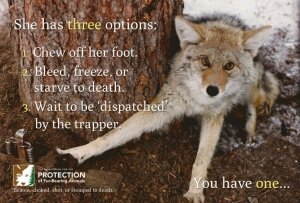 What can you do?
What can you do?
- Read this.
- Speak up! Email Canada Goose ()! Leave polite comments that make fact-based arguments on news articles about Canada Goose or the fur industry!
- Hand out/leave behind our fur education postcards too! Email [email protected] to order your FREE postcards!
Further Reading:
Wearing Pain: Canada Goose’s Fur Policy is Lame and Self-Serving.
Canada Goose: The Trendy Necessity Trap
Canada Gross
FurIsGreen.ca
We’re shooting polar bears?!?




